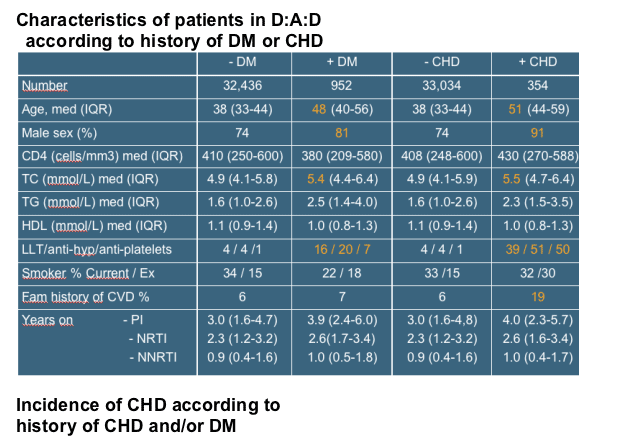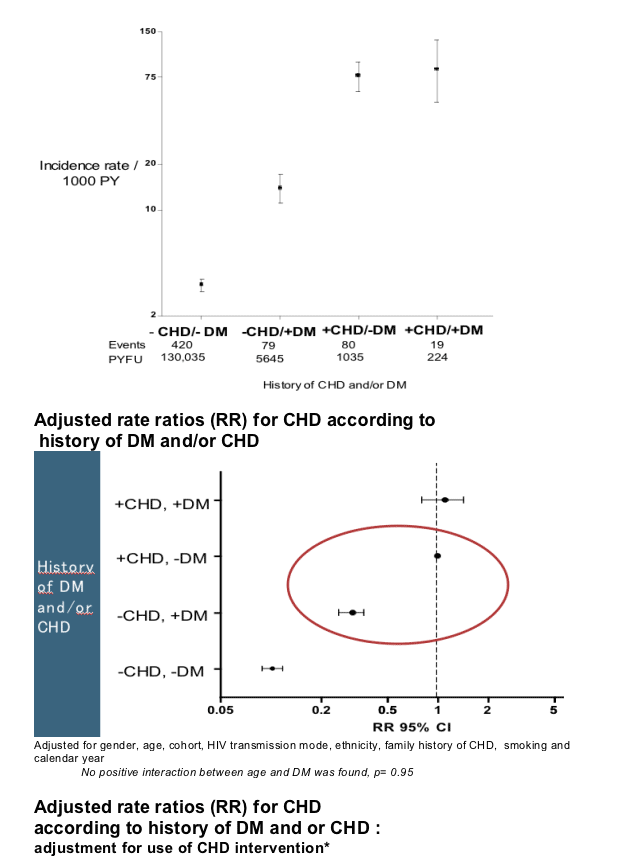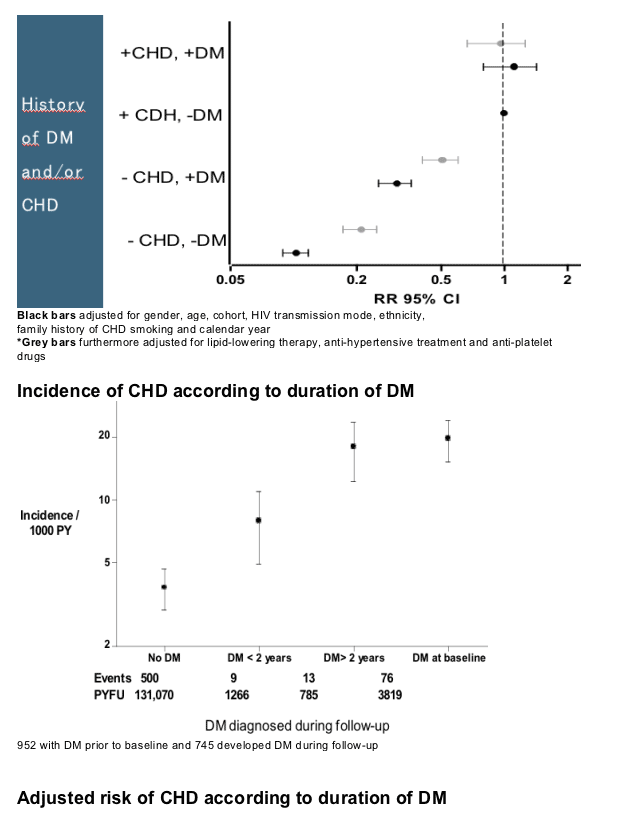 |
 |
 |
| |
Does diabetes mellitus (DM) confer an equivalent risk of coronary heart disease (CHD) to pre-existing CHD in HIV-positive individuals?
|
| |
| |
Reported by Jules Levin
9th Intl Workshop on Adverse Drug Reactions and Lipodystrophy in HIV
July, 2007
Sydney, Australia
Signe Westring Worm, Stephane De Wit, Rainer Weber, Caroline A. Sabin, Peter Reiss, Wafaa El-Sadr, Antonella D'Arminio Monforte, Ole Kirk, Eric Fontas, Francois Dabis, Matthew G. Law, Jens D. Lundgren and Nina Friis-Moller
On behalf of the D:A:D study group
BACKGROUND
In the background population patients having DM have a high risk for CHD
NCEP guidelines operate with a concept of 'CHD risk equivalent'
-- a disease conferring similar risk of CHD as pre-existing CHD

DM (Diabetes) and HIV
DM is a frequent condition in HIV
--In D:A:D, prevalence 3%, incidence 5.72 per 1000 PY*
In HIV, risk factors for DM may differ from those in the background population
--e.g. induced by ART rather than by lifestyle
It is unknown if DM should be considered a CHD risk equivalent in HIV
Clarification may have major public health implications for the prevention of CHD in HIV
*SD Wit: 8th International Congress on Drug Therapy in HIV Infection, Glasgow 2006
STUDY PURPOSE
Is DM a CHD risk equivalent in HIV?
Is the risk of CHD in patients with DM and no history of CHD, similar to the risk of recurrence of CHD in patients with a history of CHD and no DM?
METHODS
CHD: Myocardial infarction (MI), invasive procedures (angioplasty and by-pass) and fatal cardio-vascular events
In patients with and without prior CHD and with and without DM at entry to D:A:D (=baseline):
--the incidence of CHD was calculated
--Multivariable Poisson analyses compared the risk of CHD after adjustment for gender, age, cohort, HIV transmission mode, ethnicity, family history of CHD, smoking and calendar year
Patient follow-up: from D:A:D enrolment, until the first CHD event during follow-up, 1st Feb 2006 or 6 months after the patient's last clinic visit, whichever occurred first
SENSITIVITY ANALYSES
The potential modifying effect of lipid-lowering therapy (LLT),
anti-hypertensive medication and anti-platelet treatment was explored
The impact of the duration since diagnosis of DM on the risk of CHD was assessed
--Follow-up time and corresponding events were classified in 4 categories:
- No DM, prior to baseline or during follow-up
- DM during follow-up of < 2 years duration
- DM during follow-up of > 2 years duration
- DM before baseline



LIMITATIONS
Years lived with DM in this study might be too short to demonstrate the full extent of this condition on the risk of CHD
- As the study matures (and the population ages) this relationship will be more assessable
Additionally, as the cohort ages, more HIV+ might be at risk of develop DM and thereby potentially CHD
No absolute risk score, only relative
Unanswered: the question of reversibility, i.e. DM occurring shortly after
introduction of PI's - and possibly- disappearing after switch of treatment.
AUTHOR SUMMARY
- A previous CHD event is a far stronger predictor of CHD than a diagnosis of DM in HIV
- A history of CHD was associated with a markedly higher risk of recurrence of CHD, regardless of whether the patient also had DM or not
- Conversely, in patients without prior CHD, DM was an important risk factor for CHD, but however not a CHD risk equivalent
- Sensitivity analyses suggested that a higher risk of CHD may exist with longer time since diagnosis of DM
DISCUSSION
In HIV, DM is not a CHD risk equivalent
Rather, intensity of preventive interventions should be guided from estimates of absolute CHD risk
- the Framingham equation* ( Anderson version)
- the D:A:D risk equation currently under development**
DM remains an important risk factor for CHD and has important implications for targeting interventions
-- such as lipid-lowering drugs, anti-hypertensive medication and glycemic control
|
| |
|
 |
 |
|
|